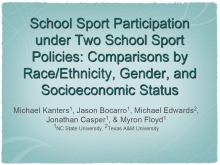We are pleased to announce an exciting new alliance between Active Living Research and GP RED to co-host and coordinate...
School Sport Participation under Two School Sport Policies: Comparisons by Race/Ethnicity, Gender, and Socioeconomic Status

Presentation at the 2012 Active Living Research Annual Conference.
View the associated research paper.
Background
Schools have been identified as a primary institution for promoting physical activity among youth (McKenzie & Kahan, 2008). Unfortunately, opportunities for physical activity during the school day and school-based extracurricular sport participation have declined in recent years particularly among middle school aged students (Sallis & Glanz, 2006). More inclusive alternative policies for school-based sport (e.g., intramurals) that emphasize participation may facilitate more opportunities for more children to participate in a wider variety of sports. However, the effect of school sport policies and students’ social and cultural background on sport participation during the middle school years is largely unknown.
Objectives
The purpose of this study was to examine sport participation among middle school students. The specific objectives of the study were to compare sport participation among students with different school sport policies (intramural vs. interscholastic) and determine if sport participation varied by race, gender, and socio-economic status (SES).
Methods
Data were obtained through an online survey administered at four public middle schools (grades 6-8) in a southeastern U.S. city. Two schools delivered sports exclusively through an intramural sports program (IM). Two population-matched schools that offered interscholastic sports (IS) exclusively, were selected for comparison. A total of 2,582 (response rate = 89.8%) students completed the survey. School sport participation was measured by asking students to identify school sports in which they had participated during the school year. Students were also asked to indicate any sports played outside of school (i.e., community sponsored sports). Participants also indicated their gender and race/ethnicity. Eligibility for free or price reduced lunch at school was a proxy for SES. Chi-square analysis was used to test for associations and logistic regression models were estimated to examine the probability of school sport participation based on each socio-demographic characteristic measured in the survey.
Results
Overall, 31% of students reported that they played school-sponsored sports over the previous school year. A higher percentage of students participated in school sport at IM schools (35.9%) than IS schools (27.3%) (ChiSq = 18.39, df = 1, p < .001, Eta =.095). There was no difference between the percentage of girls participating in school sports at IS schools and IM schools. However, there was a significantly greater percentage of boys and lower income students playing school sports at IM schools than IS schools. Black students in IM schools were more likely to participate in school sports. Conversely, there was no difference in the participation rates of White students for the two school sport models (ChiSq = 31.05, df = 1, p < .001, Eta =.208). Students at IM schools were significantly more likely to participate in all sports than students at IS schools, with the exception of track and field. The largest differences in participation rates for Black students were seen in basketball and football. Of all Black students at IM Schools, 25.9% played football (compared to 4.7% at IS schools) (ChiSq = 57.06, df = 1, p < .001, Eta =.306) and 30.3% of Black students at IM schools played basketball (compared to 8.1% at IS schools)( ChiSq = 51.32, df = 1, p < .001, Eta =.290). Relatively large differences in rates of participation for Black students were also seen in soccer (ChiSq = 46.76, df = 1, p < .001, Eta =.277), volleyball (ChiSq = 35.59, df = 1, p < .001, Eta =.238), and softball (ChiSq = 12.94, df = 1, p < .001, Eta =.146). Logistic regression results indicated that race and gender were more important predictors of sport participation in IM schools while SES was a more important predictor of participation in IS schools.
Conclusions
Study findings indicated that a more inclusive sport model attracted more student participation, particularly among students from low income and minority households. However, even though sports were co-educational at IM schools, participation remained male-dominated. This finding supports previous research that co-educational sports often retain more masculine sport values (e.g., aggression) and therefore girls may be less inclined to participate in these activities (Henry & Comeaux, 1999). Students from low income and/or Black households were more likely to participate in school sport if they were attending IM schools. Previous research suggests that roster limits imposed at IS schools’ sports programs may have prevented Black youth from participating in sports that were perceived to be culturally appropriate (e.g., football and basketball). However, sports programs at IM schools imposed no limits on participation. The removal of structural barriers at IM schools may have encouraged participation by Black students in sports traditionally dominated by White students at IS schools. Consequently, the addition of intramural sports as a complement to, or in replacement of, existing interscholastic sport programs could encourage participation among a larger segment of the population and in particular, students from low income or racial minority families.
Support/Funding
Robert Wood Johnson Foundation, Active Living Research.
- DOWNLOAD "2012_SchoolPolicy_Kanters.pdf" PDF (1.30 MB) Presentations
Related Tools & Resources
STAY UP TO DATE
RECENTLY ADDED TOOLS & RESOURCES
MOVE! A BLOG ABOUT ACTIVE LIVING
The "Active Living Conference" aims to break down research and practice silos and...







